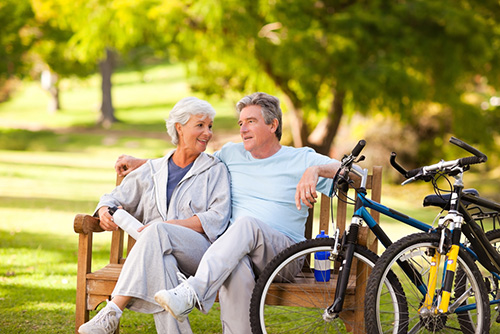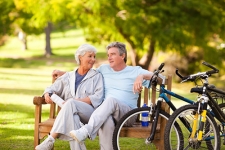Exercise and Mobility
Aging people often fear exercise, worrying that they might trip or fall. Exercise and a healthy lifestyle have a direct effect on muscle strength, joint flexibility and bone density. Though certain forms of exercise like jogging, playing tennis, etc. may not be recommended, physical activities like walking or riding the stationary bicycle not only strengthen muscles and bones, but also reducing the risk of falling. Balance exercises, like yoga and pilates, have the ability to increase core strength and aide the sense of balance, which also helps in preventing falls.

Diet
It shouldn’t be a surprise that the normal aging process results in a loss of muscles mass, even when maintaining the same weight. Muscle loss leads to diminished strength, causing mobility issues and increasing the risk of falls. In order to maintain muscle mass, eating 20 to 30 grams of protein three times a day is recommended (always check with your healthcare provider before implementing any new diet and/or exercise program). Paired with light, daily exercise, consuming an adequate amount of protein daily can help maintain and strengthen muscle.
Among elderly adults, low vitamin D is the most prevalent nutritional deficiency. Like protein, when paired with daily exercise, vitamin D has been shown to increase muscle strength. Since it’s often difficult for elderly adults to obtain adequate amounts of vitamin D from their diet or sunshine, supplements are usually recommended.
The Correct Clothing and Shoes
Beyond diet and exercise, the type of clothing elderly adults wear can affect their health. Clothing that is too tight can heat up fast and restrict blood flow, which can lead to losing short term mental capacity or motor skills. On the other hand, clothing that is too loose can get caught on doors or furniture, causing a fall.
Proper footwear is equally important as comfortable clothing. Shoes with good support promote proper alignment. Shoes that have nonskid soles are also recommended to help prevent slipping and falling.
Fall Prevention
It’s best to create an environment that prevents falls. This could be anything from having a carpeted floor instead of hardwood or tile, to having handrails on staircases, to having rubber mats in bathrooms, to picking clutter up from the ground. Sometimes rearranging the furniture to ensure there is no blocking of pathways in-between rooms is a good idea. This can extend to the outside of the house as well; keeping the walkway between the front door, driveway and mailbox clear of clutter and debris is highly recommended.
Lighting
As we age, our vision often is not as good as it once was – couple that with the need to get up more often throughout the night and you could be in trouble. For this reason, it’s a good idea to place multiple night lights in the bedroom, hallway/pathway to the bathroom, and the bathroom itself to prevent stumbling. Lighting at the top and bottom of staircases is also a good idea for those living in a multilevel house.
Other lighting tips to consider include having a lamp at the bedside for any middle-of-the-night needs and storing flashlights in easy-to-find places in case of power outages.
Review Medications
In general, medications have a more extreme effect on elderly adults than they do on younger people. Some medications have side effects that cause dizziness or balance issues. Others, like corticosteroids, increase the risk of osteoporosis. Even with over-the-counter medications, always double check all side effects and symptoms before administering to an elderly adult.

